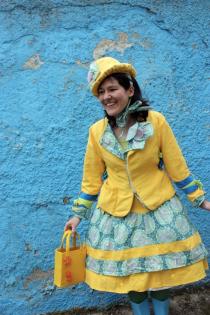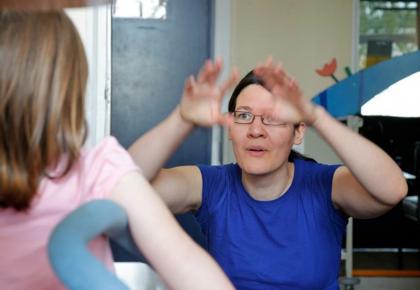INTERVIEW BY GUEST EDITOR NIAMH LAWLOR
The telling of a story to a child, to be most effective, has to be an interpersonal event, shaped by those who participate in it
Uses of Enchantment, Bruno Bettleheim p:151

Image (c) Ger Staunton
As part of my research into Story and its importance for children, particularly those in challenging circumstances, I spoke to Storyteller and Artist Fiona Dowling who has worked in both Children’s University Hospital Temple Street and Cork University Hospital for Helium Children’s Arts in Health. The discussion that ensued is paraphrased below, with later additional input from Fiona, so that it’s reporting is, fittingly, a collaboration in itself.
The original discussion was loosely based on a series of questions, emailed in advance to Fiona, that can be seen (and responded to) at THIS LINK.
In the text below I have put quotes from Fiona in bold type my own commentary and paraphrasing is in regular, and quotes from other sources are italicised and credited.

Image (c) Samantha Hunt
In the text below I have put quotes from Fiona in bold type my own commentary and paraphrasing is in regular, and quotes from other sources are italicised and credited.
When asked about her working process in the hospitals where she had been collaborating with musician Caoimhe Conlon, Fiona said that she felt having fun was a priority, due to the challenges children experience in this context. She said she tended to respond instinctively to the space and the mood and needs of the children - sometimes working individually from bed to bed, sometimes working with the whole ward (usually 4-6 beds). Sometimes she was guided by the hospital Play Specialist’s advice on who to work with. She would be in the hospital typically for about three hours and would try to engage with as many children as possible during that time - usually reaching between 14 and 25 children.
Some stories are only a few minutes long, the longest is 10 minutes, the short ones tend to contain audience interaction. When I worked with the musician, first she played a tune (to break the ice or say hello), then I would tell a story that she would accompany on the flute, then the patients would be given instruments and get to accompany the story as I told it again, adding sound effects, or else they would create their own compositions. When I worked with the musician our common repertoire was of 6, 7 stories. When I work on my own, there are about 25 different stories or songs I might use, as well as some riddles.
She illustrated our discussion with many stories so that I felt I was receiving a private performance myself and could get an understanding and reminder of how valuable this medium is in transporting, energising and inspiring. Although half Irish and French and completely bi-lingual, her french accent adds a particular flavour and charm to her work.
When working with someone very young, she says she tends to go very silly and gave the example of a story about a little boy who doesn’t want to go to sleep, which she punctuates with a sung refrain with sounds and actions the children can join in on. She says she likes to choose stories which could be about their own lives, maybe about naughtiness, and which are full of the fun of telling. In choosing a story it has to be fun for her too and to have some meaning for her, so that she can bring something to the story and, so, to them.
She likes to include interactive elements where possible, for example a pig stuck on a bridge that gets to eat a variety of foods that the children suggest. The children also respond well to the fact that they can identify with the star of this story, something Fiona ensures :
I describe the star of the story to look exactly like the child I am telling it to: if it’s a boy, the star is a boy, if a girl with pigtails, the star is a girl with pig tails!
They respond also to the crude humour in it. The pig burps loudly, and when someone says "Oh! You are such a pig" he responds with "Oh. Thank-you!"
Another story she has found popular with the under nines involves making - she folds and tears paper while narrating which results in a t-shirt with their own name on it.
With teenagers, however, she takes a different approach. She likes to give them a story with a bit more depth, something perhaps which encourages accepting yourself with light and dark bits. She gave a lovely example of an African story about a huge huge tree with two symmetrical branches. But it was more than just a tree, it was a friendly presence in peoples’ dreams and people used to pray to it. But although it was rich with fruit, no-one ate from it because of a legend that one branch bore healthy and delicious fruit and the other highly poisonous fruit, and no-one knew which was which. When a famine came and the tree remained healthy, an elder decided to risk it and ate a piece of fruit. Another grew back in its place and the elder remained healthy, so they all celebrated and had a feast. In due course, however, they decided to cut off the bad side of the tree now that they knew which was which, so no-one could be harmed. When they did this, however, amputated from its bad side, the tree no longer bore fruit and died. The story invites us to see ourselves as similar to the tree and to make peace with our darker aspects - which Fiona feels particularly relevant in the teenage years
Sometimes however she might do a portrait of a teenager instead of telling them a story or she might exchange jokes and riddles with older children.
When we came to discuss the elements of stories and what she feels of most importance, she says their fictional and fantastical nature is crucial and that, combined with absurdity and silliness, can help remove us from ’real life’ allowing a creative distance. She feels it is important for children to see adults engaging with this too, that they are playing with them is important.
I am convinced of this idea that health comes quicker if the child wants to get healthy, if they have a positive attitude towards life, and towards themselves, so with my stories and interventions I try to appeal to the health in the child, to their spirit, their sense of fun, their lust for life, in order to magnify that, and help the child to feel their own resources inside. Laughter, wonder, play and imagination, all contribute to increasing the sense of the child’s own resourcefulness.
She feels the journey of a story is important, that it takes us from a beginning to an end, almost as if we have travelled ourselves, allowing for transformation through the story - catharsis.
She feels magic is important, trickery, drawing : ..magic brings a sense of hope and possibility that is directly linked to the possibility of health: If everything is possible, if a paper boat can turn into tee shirt, if a few lines on a piece of paper can turn into an image of me, then my health coming back is also possible.You start telling a story, and with each new element of the story, you make a little mark on a piece of paper, a line, a circle... The magic resides in the fact that by the end of the stories all those little marks make the image of something relevant in the story: a monkey, a dog, a bear, or a teapot.
The magical structure of things happening in threes, is important too, providing an underlying elegance and formal structure created with language. She feels a Happy Ending is important too, particularly in a hospital context. Or, if there isn’t a happy ending, that there is a moral : ...a moral that is life enhancing or life affirming - like that of the tree story.
Dreams coming true is a theme she particularly enjoys for this work:
I tell a story called The Boy Who Had a Dream - where a boy refuses to disclose a wonderful dream he has had. In exchange for his dream a witch and a whale give him magical items but he never tells them his dream.Thanks to the magical items, he brings a princess back to life and finally discloses his dream to the father of the princess, telling him the dream finishes when he says to him ’You may have my daughter’s hand in marriage’ - Because he held on to his dream, his dream came true!
Story satisfies a deep need for her, it is as if it is good food allowing a different take on life, to support you on your journey through it.
As inspirations she referred to the work of Pat Ryan who she saw at Story Spark in The Ark who recommends make them laugh in hospital.
I was surprised at first because I thought the stories in hospital had to be somewhat solemn, but now I completely understand his choice, there is nothing more rewarding than to see a child burst into a smile or a fit of giggles! Especially if they were looking sad or down before the story started. When you see the smile or giggles, you know that health is there... And I am also aware of Patch Adams and the link between laughter and health.
She also searches for stories online, and referred to the Story Bee website as a good source.
She referred to Bruno Bettleheim’s Uses of Enchantment, in particular the chapter about parents reading for children where he says
Slavishly sticking to the way a fairy story is printed robs it of much of its value
This can inhibit it as a means of conversing adult to child through the metaphor of story and preventing the reactions and interest of each in participation to en-richen the telling and make it more pertinent.
Telling is preferable to reading because it permits greater flexibility
Bettleheim also believes that if an adult tells a story about a bad or angry wolf, that means the parent knows about being angry, and that is reassuring to the child who might fear or be ashamed of their own dark impulses. In this way, and through his representation with ’creative distance’, couched in the security of narration, the bad wolf can be important to young children, helping them to face and deal with fear.
As we leave Fiona she is preparing to return to hospitals for Helium in the company of fellow artist and storyteller Eleonore Nicolas wearing specially created Storydresses with embedded lights and sounds. More information on this, including a charming film, can be seen at http://www.fundit.ie/project/the-storytellers-new-gambit, where they were successful in their funding campaign.
That is the start of a new adventure in magic.
Niamh Lawlor, June 2013
Photographer credits: Storydress shots: Ger Staunton & Image of Fiona in the hostpital: Samantha Hunt


No comments added